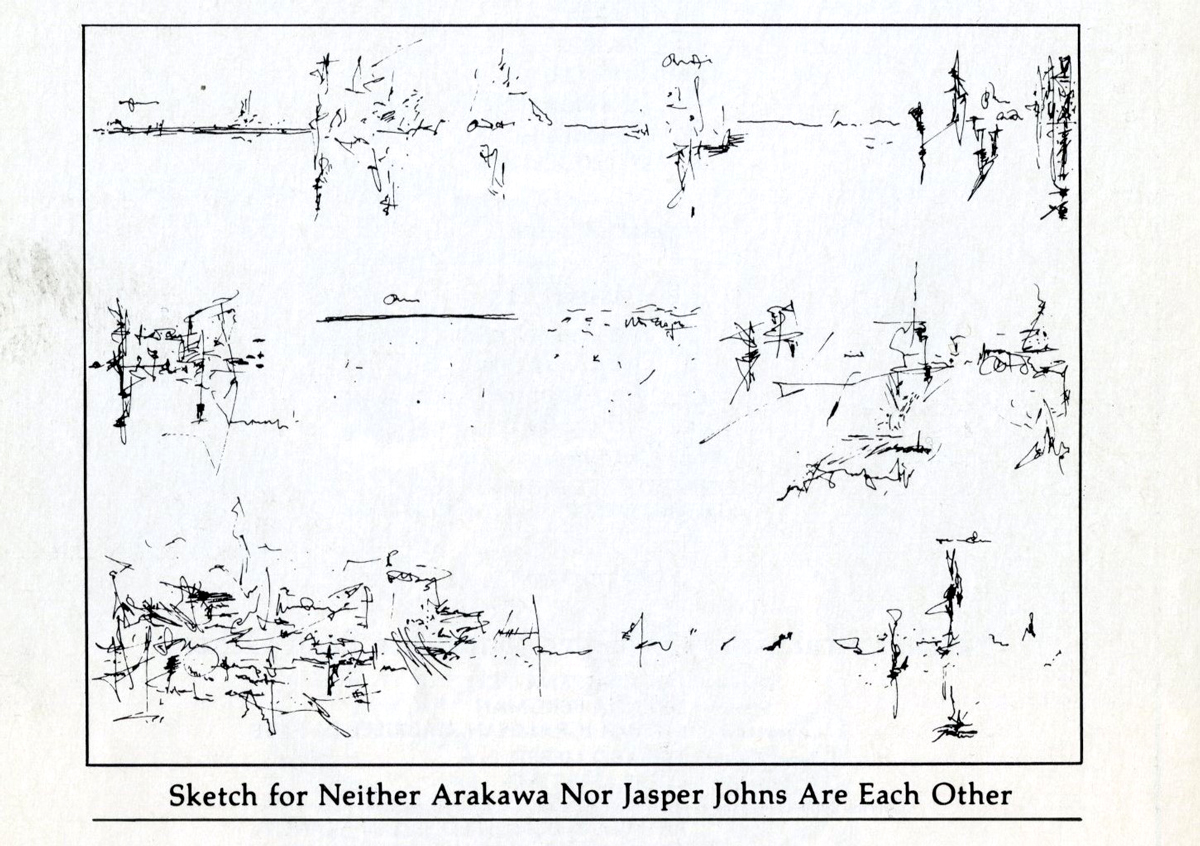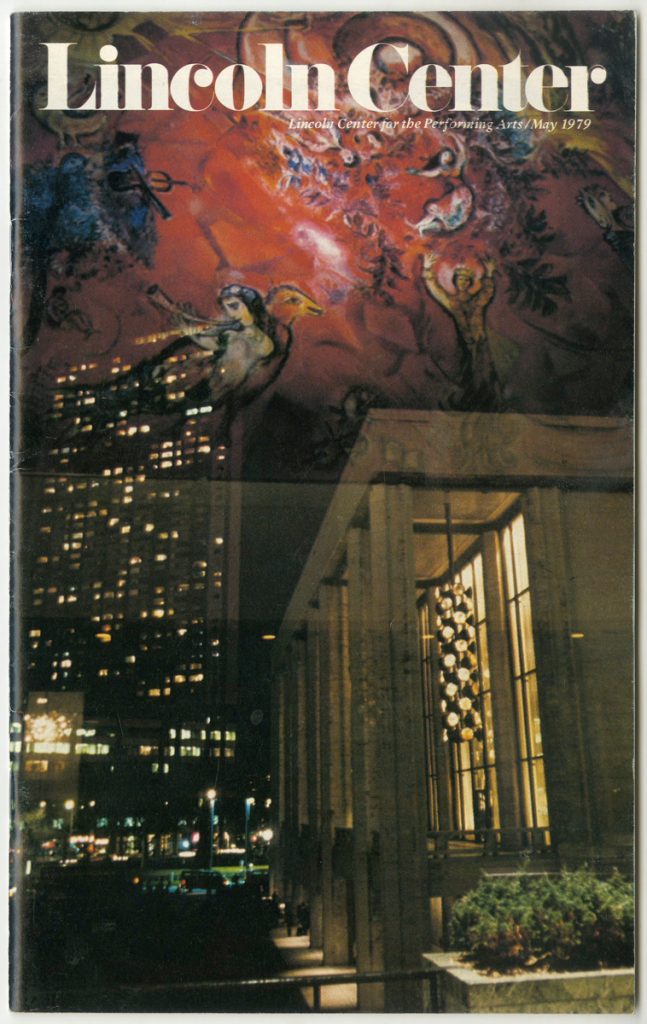
Dear Friends,
In Ambiguous Zones 13, RDF’s project archivist, Kathryn Dennett, delves into the story behind a mysterious find in an archival box: a Lincoln Center playbill from May 1979…mentioning Arakawa. This playbill was for an evening performance by composer Edvard Lieber that included a composition entitled “Neither Arakawa Nor Jasper Johns Are Each Other.” Taking this intriguing piece as her starting point, Kathryn outlines Lieber’s career, highlighting a second piece inspired by Arakawa’s work, in this case, Blank Stations II, 1982, performed at the Wadsworth Atheneum in Hartford.
Yours in the reversible destiny mode,
Reversible Destiny Foundation and the ARAKAWA+GINS Tokyo Office
*Ambiguous Zones has now moved to a quarterly schedule. We’ll be sharing AZ content with you every three months and any important news updates as they arise!*
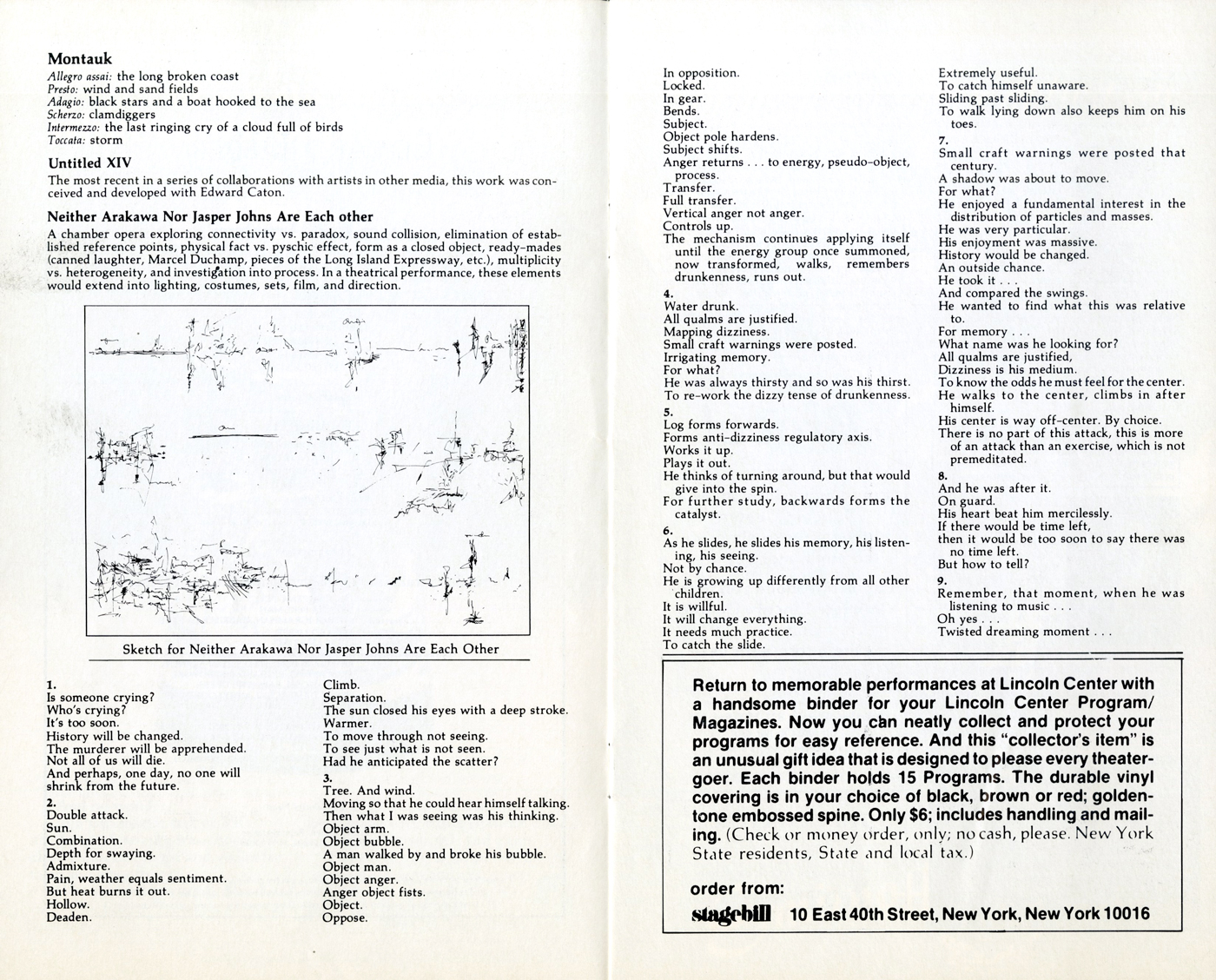
As the archivist at the Reversible Destiny Foundation, I am familiar with a variety of types of sources: poem drafts, preliminary sketches for paintings, scientific research articles, digital renderings of architectural projects, and many other traces of the multifaceted artistic practices of Arakawa and Madeline Gins, but I have never found any evidence of the pair as composers. Accordingly, I was surprised to come across a playbill from the Lincoln Center for the Performing Arts in a folder labeled “copies of press,” which mainly included reviews of Arakawa exhibitions from the 1960s.
The playbill from May 1979 documented a night of music by the composer Edvard Lieber,[1] including a composition entitled “Neither Arakawa Nor Jasper Johns Are Each Other.” We have a few pieces of scattered correspondence from both Johns and Lieber in our collection that point towards their shared membership in the downtown New York City contemporary art scene of the period (fig. 2). Among these items, there is a Christmas card from Lieber to Arakawa featuring a drawing similar to the visual included in the Lincoln Center playbill. So far, I have yet to find any record in our archive of how this piece came to be and what collaboration, if any, there was between the composer and his titular subjects. The two artists did, however, each contribute a work that was incorporated into the poster for the evening, a copy of which is now in the Library of Congress collection.[2]
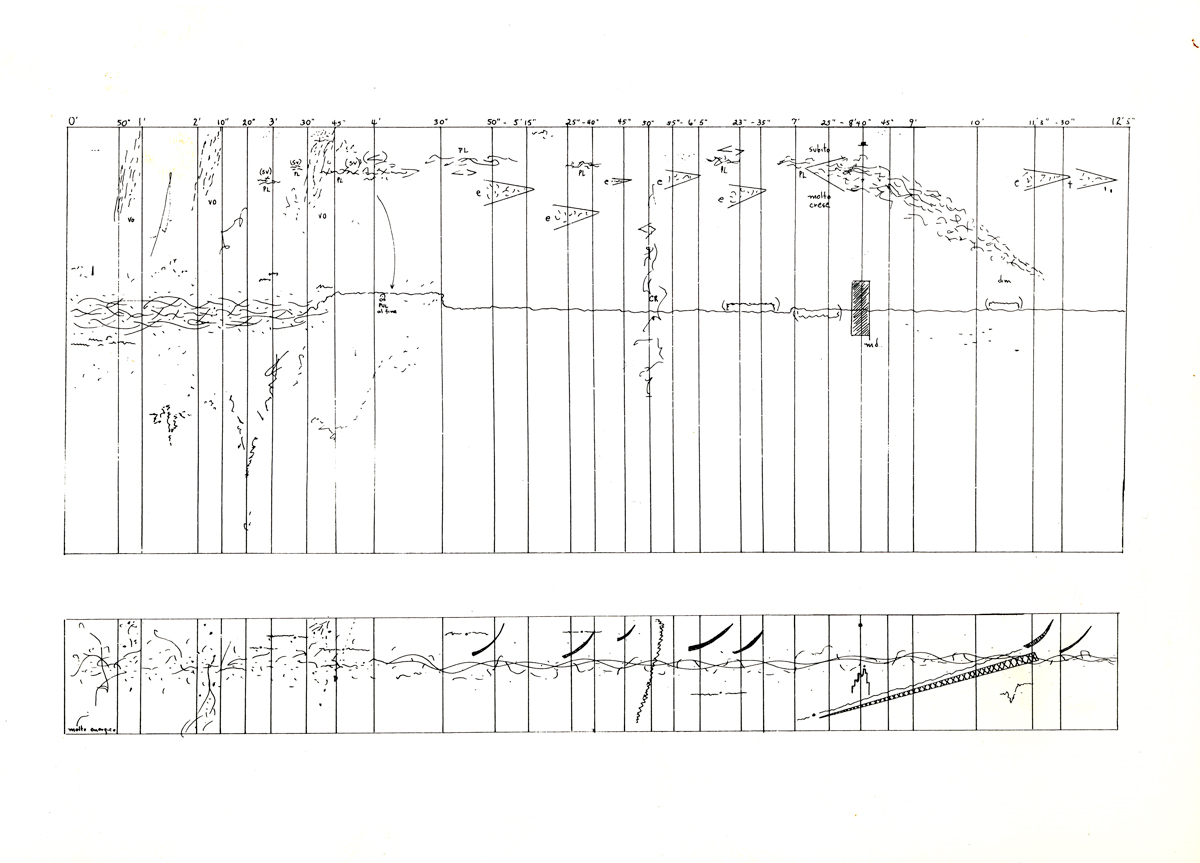
Unable to find a recording of the piece itself, I was left to imagine the performance based on descriptions from the time. In Lieber’s program notes, he summarizes the work as follows:
[a] chamber opera exploring connectivity vs. paradox, sound collision, elimination of established reference points, physical fact vs. psychic effect, form as a closed object, ready-mades (canned laughter, Marcel Duchamp, pieces of the Long Island Expressway, etc.), multiplicity vs. heterogeneity, and investigation into process.[3]
While conceptually rich, this synopsis is not much help in determining what this would have sounded like. Thankfully, the critic John Rockwell reviewed the evening, not particularly positively, in the New York Times. The article, despite the writer’s misgivings, gives us a clearer picture of the composition: “26 performers alternately speaking, hissing, chanting, moaning, singing, playing percussion and other instruments or manipulating cassette recorders.” Rockwell does admit that the resulting piece held a “dim allure” reminiscent of earlier avant-garde works of choral composition from the 1960s.[4]
I could now imagine a crowded stage, and, while I could not quite imagine what sound these disparate sources would come together to create, having not listened to much 1960s avant-garde choral music, I was starting to see possible connections between Arakawa’s art and artistic practice and Lieber’s composition. As Helen A. Harrison pointed out in a 1979 article in the Times about Lieber’s work when it debuted on his native Long Island, visual art inspired by music is much more common than the opposite approach, at least stated as explicitly as Lieber does. He explained that he did not approach the process as a literal translation; rather, he based his works “less on the visual impact of the canvases and more on their suggestive qualities.”[5] By creating music based on his subjective experience of paintings, Lieber was externalizing the process that takes place in the brains of many viewers of art. A process that, at the time, was relevant to Arakawa’s work, particularly in regard to the Mechanism of Meaning and other diagram paintings meant to externalize the process of how cognition, imagination, and other internal processes take place.
With this intriguing echo in mind, I went searching for more information about Lieber, given the relative lack of traces he left in our archive. A concert pianist in addition to a composer and filmmaker, Lieber would go on to compose extensively in relation to the work of Willem de Kooning, publishing both a book and CD, Willem de Kooning: Reflections in the Studio. Lieber later worked for de Kooning as a secretary and curator in the late 1980s.[6] An early work in this vein, entitled “Montauk”, was presented immediately preceding “Neither Arakawa Nor Jasper Johns[…].” Lieber told Harrison that when putting together a program of his art inspired pieces, he “arranged them in the way you hang paintings in an exhibition. You have to keep moving them around and see which go best together.”[7]
One can then think of “Neither Arakawa Nor Jasper Johns[…]” as a kind of dual exhibition. Crafting a composition suggested by the qualities in paintings by both Arakawa and Jasper Johns, while making the clear distinction, in the title at least, between the sounds their works evoke to Lieber’s ear.
In addition to the Times articles from 1979, my research turned up a 1982 exhibition pamphlet from the Wadsworth Atheneum Matrix ‘72 Arakawa show that includes an announcement that Lieber will be performing a “new piece inspired by Arakawa’s Blank Stations II” in conjunction with the show.[8]
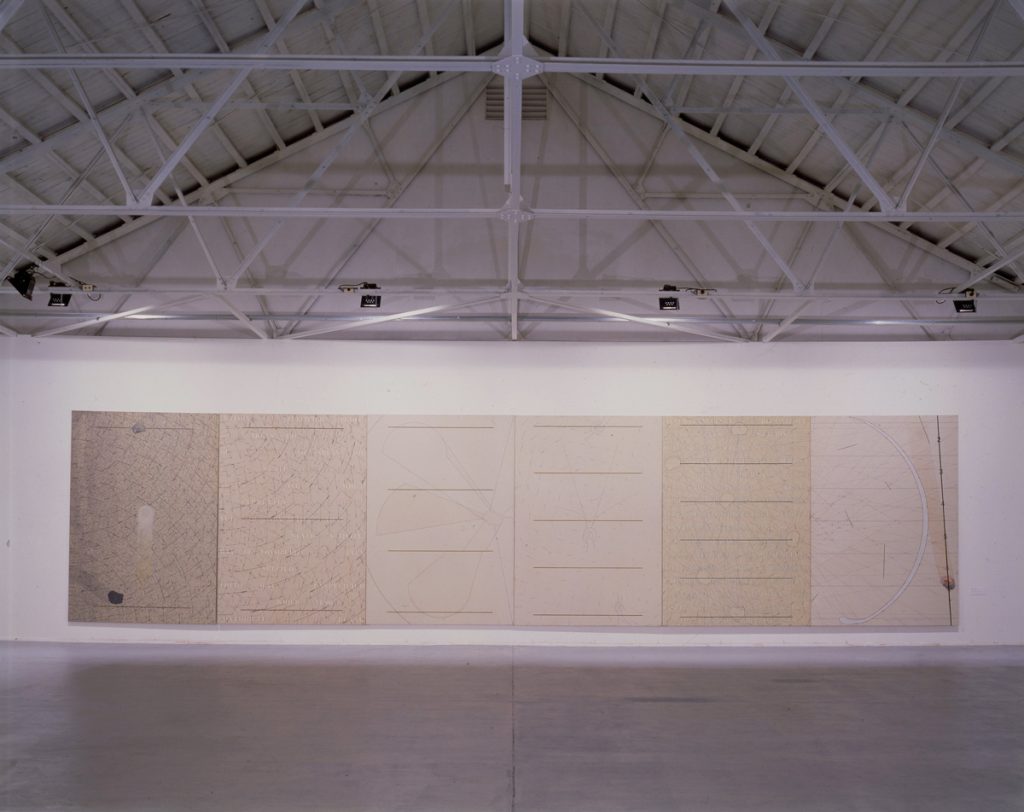
In the pamphlet, Danielle Rice, the Wadsworth’s Curator of Education at the time, wrote that Arakawa’s paintings demonstrated his awareness “of the shortcomings of language and language based thought. Since his arrival in the United States in 1961 he has been attempting to map the thinking field, as he came to call it, by combining words, numbers, lines, shapes and colors in his works.”[9] This intrigued me about Lieber’s choice of the work in question, which Rice goes on to describe as “[t]oo large ever to be encompassed in one glance, a work like Blank Stations II requires that we allow our eyes to drift over the surface, picking up images at random while we slowly decipher the written message,” a process she describes as a kind of “meditation.”[10] Although, unfortunately, I was also unable to find a recording of this piece, I was left wondering if Lieber’s piece in response to this painting could be described as his own meditation, a document of his response to Arakawa’s invitation to contemplation.
This is where I find the most interesting similarity between Lieber’s work and Arakawa and Madeline Gins’s project at this time, though at first glance, or to a traditionally trained eye (like a music critic from the New York Times) the end results can appear chaotic—clanging bells and manipulated tape recorders or arrows and seemingly impossible directions—both Lieber and Arakawa and Gins are working to use their own mediums to express something that language does not quite capture.
In the end, I came out of my research rabbit hole with more questions than I began with, but that is often the case with archives. We are left with intriguing traces of history that point to the gaps in our collections and our understanding, but my work of cataloging and describing our seeming chaos is ongoing, and I hope to find, if not more answers, more interesting questions as I carry on.
[1] Referred to elsewhere as both Edward and Eduard Lieber, I have chosen to go with the name on the playbill and Lieber’s published book.
[2] “Edvard Lieber.” 1979. www.loc.gov. 2004. https://www.loc.gov/pictures/item/2006675113/.
[3] Lieber, Edvard. “Neither Arakawa Nor Jasper Johns Are Each Other.” Program for Edvard Lieber’s Three World Premiers at Lincoln Center for the Performing Arts, New York. Playbill, May 1979.
[4] Rockwell, John. “Music: By Eduard Lieber.” New York Times (New York), May 10, 1979. https://www.nytimes.com/1979/05/10/archives/music-by-edvard-lieber.html.
[5] Harrison, Helen A. “The Lively Arts: De Kooning’s Art Inspires Composer.” New York Times (New York), March 18, 979. https://www.nytimes.com/1979/03/18/archives/long-island-weekly-the-lively-arts-de-koonings-art-inspires.html.
[6] Lieber, Edvard and Willem De Kooning. 2000. Willem De Kooning: Reflections in the Studio. New York: H.N. Abrams.
[7] Harrison, 979.
[8] Arakawa: Matrix 72. 1982. Hartford: Wadsworth Atheneum. https://www.thewadsworth.org/wp-content/uploads/2011/07/Matrix-72.pdf.
[9] Rice, Danielle. “Arakawa.” In Arakawa: Matrix 72. 1982. Hartford: Wadsworth Atheneum. https://www.thewadsworth.org/wp-content/uploads/2011/07/Matrix-72.pdf, 2.
[10] Rice, 4.
Top image: Cover of Lincoln Center Playbill, May 1979, 124 W Houston Documents, Box 4N14, Folder 50, Reversible Destiny Archives.
